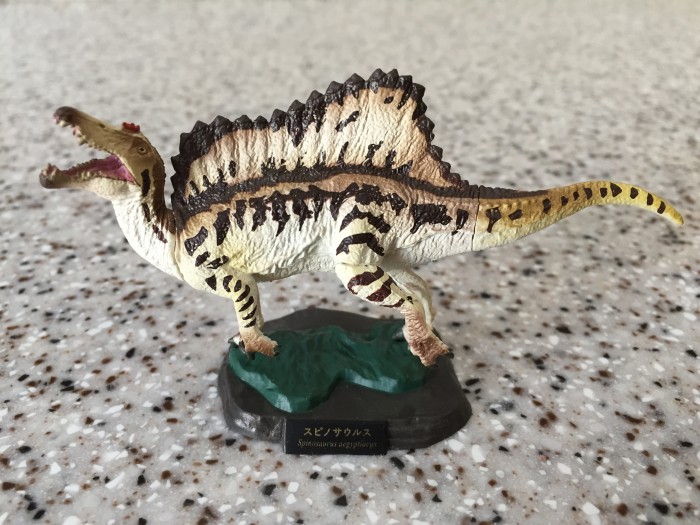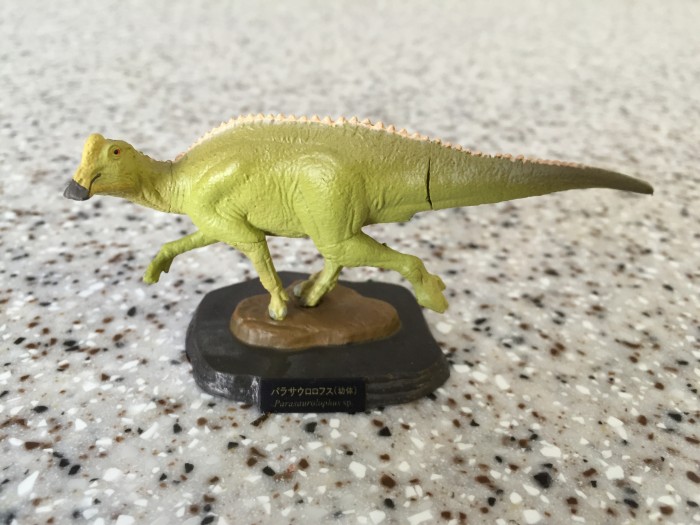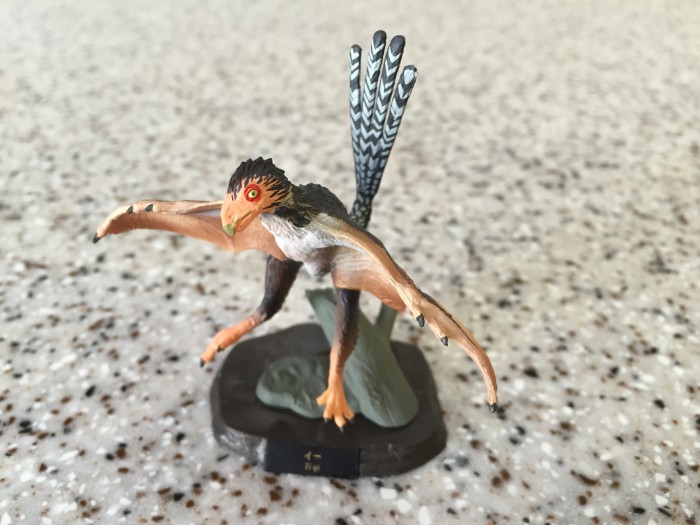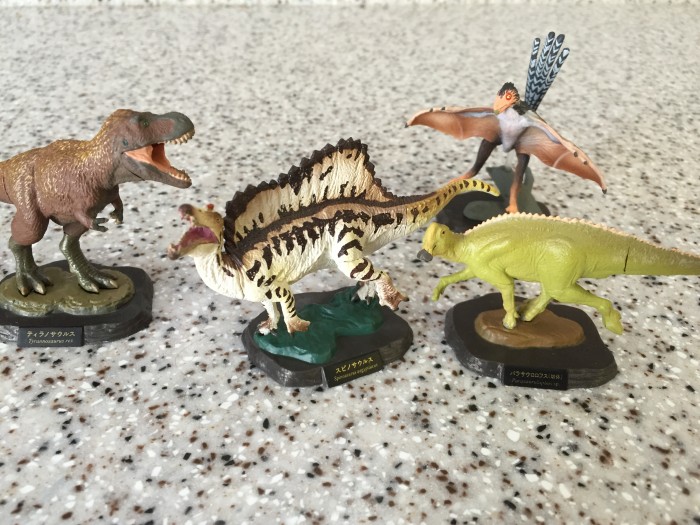In the first half of 2016, the National Museum of Nature and Science in Tokyo, Japan, held an event simply named ‘The Dinosaur Expo’ (still ongoing at the time of writing). Though I haven’t been myself, the exhibit seems to focus on recent dinosaur discoveries, with an accompanying set of figures. The set contains four figures, with a good mixture of old and new: Spinosaurus, Tyrannosaurus, Parasaurolophus, and Yi. All figures have a base with an attached name plate, with names written in Japanese on top and English below.

Based on the exhibit’s online promotional material, it seems that a big selling point was the new (2014) Spinosaurus depiction. While this interpretation is still quite controversial and unsettled (pending the publishing of the long awaited monograph along with future fossil finds), this figure represents it quite faithfully. All the unique traits that shocked the paleontological community upon its reveal, such as the staggered sail, short legs, and long torso, are present. Even the color scheme is virtually identical to the model produced for National Geographic’s exhibition promoting the discovery’s press release. The only accuracy complaint is that the base of the tail is rather thin. As indicated by its unique anatomy, Spinosaurus was largely aquatic, so would have likely had thick tail muscles (like seen in extant crocodilians) for locomotion.

Of course, no discussion of Spinosaurus would be complete without the infamous Tyrannosaurus rex. Kaiyodo is no stranger to fully feathered tyrannosaurs, and this T. rex only has its feet, fingers, and parts of its face bare. The feathering, while extensive, is not overbearing and looks quite realistic. There are even slightly larger tufts along the neck and tail tip. The rest of the anatomy is also correct – even the ears are in the right portion of the skull (T. rex‘s skull bones show its external ear hole would have been positioned more in relative to other theropods, which had it behind the skull). The coloration is fairly monotonous and dull, which is reasonable for an ambush predator but doesn’t make for the most striking aesthetic.

This next figure isn’t something you see everyday – a juvenile dinosaur! The base labels it as Parasaurolophus sp., and it is presumably based off the first juvenile of this genus discovered in 2013 (also referred to Parasaurolophus sp.), estimated to only have been a year old at death. This figure conveys one of the specimen’s most significant aspects – the beginnings of the distinctive tubular head crest. The presence of crest development in such a young individual is one possible reason Parasaurolophus had a crest much larger than other hadrosaurs – it got a head start in terms of growth time. The row of bumps forming a ‘frill’ down the back is known for other hadrosaurs like Brachylophosaurus so is a plausible inclusion. There are even hints of small, regular scales, consistent with findings from hadrosaur ‘mummies’ of various genera. The dark line along the jaw would seem to suggest Kaiyodo is going for a ‘cheekless’ depiction, as they did in their earlier Ceratopsian Collection. Whether or not ornithischians had cheeks is a hotly contested issue, with evidence supporting both sides, so Kaiyodo’s decision to imply their absence is reasonable. Once again, the coloration is rather plain, but in many cases young animals are rather drab compared to their adult counterparts. One can easily imagine the yellow crest becoming much more distinct if this juvenile should survive to adulthood.

Last but not least is Yi qi, one of the hottest dinosaur discoveries of 2015. It’s actually quite impressive Kaiyodo managed to produce and release a figure of it in under a year! Dinosaurs have often been compared to dragons and played a role in the original folklore, but Yi is as close to the real thing as it gets – it even had membranous wings! This figure presents a well-proportioned, accurate depiction of this theropod’s odd anatomy- the center of gravity is relatively far back as it would have been in life (as opposed to some of the horizontal glider depictions permeating through the media). Actively posed, this Yi is mid-air and making full use of its wings to control its descent to the ground, a use suggested by paleontologists. The only known fossil actually does not include the tail, but it is widely believed that Yi had the long tail feathers depicted based on remains of close relatives like Epidexipteryx. It’s worth noting that the tail piece is the figure’s most fragile – care must be taken not to allow individual feathers to bend or snap off. This figure has one of the set’s more striking colorations – the tail feathers have detailed filament patterns, and the fleshy underside and red markings surrounding the eyes contrast with the back’s dark grey to give the animal a spooky appearance, slightly reminiscent of Halloween.

All in all this is an outstanding set depicting recent paleontological discoveries and advances, with a mix of both classic and new genera. Given that Kaiyodo’s figures have always scored highly in accuracy this is no surprise. In addition to accuracy and scientific progress, these figures also have excellent production values, with fine details and precise paint applications – every claw, tooth, and even pupil is clear. The bases with nameplates are a nice inclusion, giving these figures an appropriate museum-like air. I highly recommend this set to all dinosaur lovers who enjoy keeping up with the latest paleontological developments. The set was originally available from vending machines at the exhibition, but can be obtained through eBay or Japanese sellers. A word of caution though – the Spinosaurus may be harder to track down than the others. It was first sold alongside pre-paid advance tickets to the exhibition (which sold out quickly), and was a rarer chase figure at the exhibition’s machines.
Disclaimer: links to Ebay and Amazon on the DinoToyBlog are affiliate links, so we make a small commission if you use them. Thanks for supporting us!



where did you get these? those figures are really good!